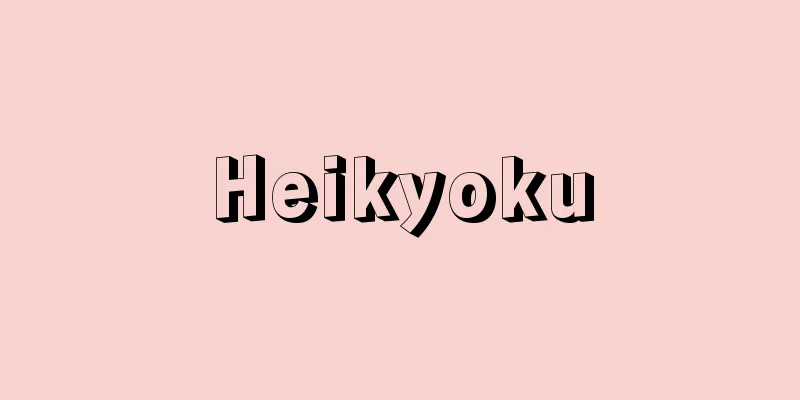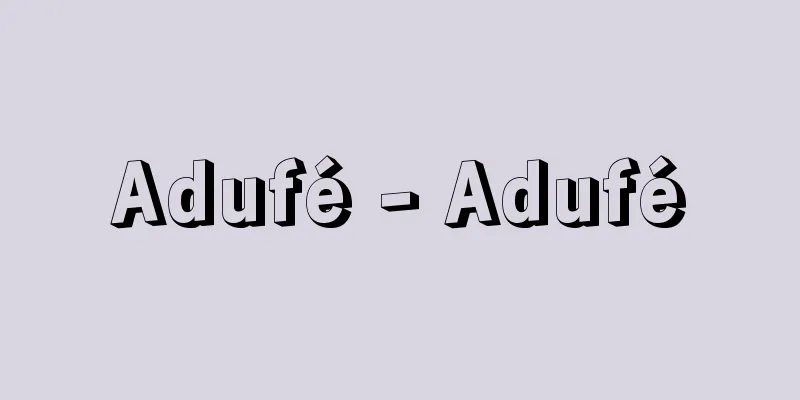Heikyoku

|
A type of storytelling performance in which the lyrics of "The Tale of the Heike" are performed to the accompaniment of the biwa. It is also called "Heike Biwa" or "Heigo." It was passed down by blind performers until the Muromachi period, and from the Edo period onwards, sighted performers also appeared. [Sylvain Guignard] History and styleIt was established in the early 13th century, with the three elements of gagaku, shomyo, and the blind monk's biwa as its origins. In the 226th chapter of Tsurezuregusa, it is said that it was created in the early Kamakura period with the cooperation of Yukinaga, the former governor of Shinano, and a blind monk named Shobutsu, but there are many different theories about its origin. About 100 years later, during the Nanboku-cho period, a master named Kengyo Akashi Kakuichi (1300?-71) appeared and improved the words and melody, arranging it into the form we see today. It was also during Kakuichi's time that the ranking system for blind people called "Todo" was established, with the highest-ranking person called Kengyo, and later the person with the highest rank called Sokengyo. From this point on, the Muromachi period was the golden age of Heikyoku. Even in the Edo period, it was protected by the shogunate and was not driven out by the popularity of the shamisen. Tokugawa Iemitsu in particular loved Heikyoku and had Hatano Koichi Kengyo (?-1651) establish the Hatano school in Kyoto and Maeda Kuichi Kengyo (?-1685) establish the Maeda school in Edo. Ogino Tomoichi Kengyo (1731-1801), who studied both schools in Kyoto, went to Nagoya and created a score called "Heike Mabushi" (completed in 1776). This excellent work can be said to be a culmination of the many scores for sighted Heikyoku lovers, and is still the standard score for the Maeda school to this day. In the Meiji period, the policy of protecting this school was abolished, and the Hatano school in Kyoto was effectively discontinued with the death of Fujimura Seizen (1853-1911). Meanwhile, the Maeda school spread not only to Nagoya but also to the Tsugaru domain, which was enthusiastic about Heike music, and the domain's samurai Tateyama Zennoshin wrote "Heike Music History" in 1910 (Meiji 43). After World War II, three Nagoya kengyo, Inogawa Koji, Doizaki Masatomi, and Mishina Masayasu, and Sendai's Tateyama Kogo (Zennoshin's son), were selected as "intangible cultural properties for which measures such as record keeping should be taken." These arts were on the verge of extinction, but Tateyama's disciple Hashimoto Toshie is active in Tokyo, and a small number of them are still being passed down in Nagoya. [Sylvain Guignard] Song TypeEach chapter of "The Tale of the Heike" is counted as one piece (called one verse), and there are a total of more than 200 pieces of Heikyoku. Under the transmission system, these are divided into (1) Hiramono (the majority of the pieces), (2) Denjumono (also called Naraimono, 33 pieces), and (3) Hiji (five pieces). Ogino Kengyo defined the learning of Heikyoku as follows: The first rank is to master 50 Heimono pieces, after which one learns the "Yomimono" (13 pieces) from the Denjumono. Those who have mastered 100 or more Heimono pieces will learn the "Gokumono," "Enjomono," and "Soroimono" (all five pieces) from the same Denjumono before being initiated into the "Kanjo no Maki" (the five chapters following "Nyoin Goreika"). The secret pieces are two pieces called "Small Secrets" (Gion Shoja and Engiseidai) and three pieces called "Dai Himitsu" (Shuron, Ken no Maki, and Mirror no Maki). These were only taught to the Sokengyo and were so highly respected that they were only to be performed three times in a lifetime. [Sylvain Guignard] Songs and instrumentsEach chapter (verse) of Heikyoku is made up of a combination of typical parts called kyokusetsu. There are about 50 types of kyokusetsu, such as "kudoki," "shoju," "sanju," and "ageuta," but there are only about 11 major types. Each has a different scale, pitch, and rhythm, and is related to the content of the lyrics, such as the "hiroi" kyoku in battle descriptions. The lyrics and kyokusetsu had a great influence on Noh, Joruri, Jiuta, and Sokyo after Heikyoku. The Heike biwa used in Heikyoku is slightly smaller than the gagaku biwa, with four strings and five pillars. It is played by pressing between the pillars. According to Ogino Kengyo, the tuning is A2 - C3 - E3 - A3 , but it is slightly different in modern Heikyoku. The plectrum is often made of boxwood, and both ends are sharp. The biwa plays the introductory and interlude parts of the melody, and is not played along with the lyrics. The hand of the biwa is determined by the melody that follows before "Kudou", like "Kudou bachi". [Sylvain Guignard] "Reprint of 'The Music History of the Heike Clan' by Tateyama Zennoshin (1974, Geirinsha)" [References] | |Source: Shogakukan Encyclopedia Nipponica About Encyclopedia Nipponica Information | Legend |
|
『平家物語』の詞章を琵琶(びわ)の伴奏で弾き語りする語物(かたりもの)の一種。「平家琵琶」「平語(へいご)」ともいう。室町時代まで盲人演奏家によって伝承され、江戸時代以降は晴眼者で演奏する者も現れた。 [シルヴァン・ギニアール] 歴史と流派13世紀初めに雅楽・声明(しょうみょう)・盲僧(もうそう)琵琶の三者を源流として成立。『徒然草(つれづれぐさ)』第226段には、信濃(しなの)前司行長(ゆきなが)と生仏(しょうぶつ)という盲僧の協力で鎌倉時代の初めころつくられたとあるが、その成立をめぐっては多くの異説がある。約100年後の南北朝時代になると、検校(けんぎょう)明石覚一(あかしかくいち)(1300?―71)という名人が現れて詞章・曲節に改良を加え、現行のような形に整えたとされる。「当道」という盲人の位階制度ができたのも覚一のころで、最高位者を検校、のちには最高責任者を総検校と称した。これから室町時代が平曲の最盛期である。江戸時代に入っても幕府の保護を受けていたため、三味線の流行にも駆逐されることなく、とくに徳川家光(いえみつ)は平曲を愛好して、波多野孝一(こういち)検校(?―1651)に京都で波多野流を、前田九一(くいち)検校(?―1685)に江戸で前田流を開かせた。京都でこの両流を学んだ荻野知一(とものいち)検校(1731―1801)は、名古屋に出て『平家正節(まぶし)』(1776成立)という譜本をつくった。数多い晴眼の平曲愛好者のための譜本の集大成ともいうべき優れたもので、今日まで前田流の規範譜である。明治に入ると当道保護の政策が廃止され、京都の波多野流は藤村性禅(せいぜん)(1853―1911)の死によって事実上の断絶をみた。 一方、前田流は名古屋のほか平曲に熱心であった津軽藩にも伝わり、藩士館山漸之進(たてやまぜんのしん)は1910年(明治43)『平家音楽史』を著した。第二次世界大戦後は、名古屋の井野川幸次、土居崎正富、三品正保の三検校と、仙台の館山甲午(こうご)(漸之進の子)の4人が「記録作成等の措置を講ずべき無形文化財」に選択された。これらの芸筋は廃絶しかかったが、館山の弟子橋本敏江が東京で活躍しているほか、名古屋でもわずかに伝承されている。 [シルヴァン・ギニアール] 曲の種類平曲は『平家物語』の各章を一曲(一句という)として数え、全200曲余、これを伝習制度上、〔1〕平物(ひらもの)(大部分)、〔2〕伝授物(習(ならい)物ともいい33曲)、〔3〕秘事(ひじ)(五曲)に分ける。荻野検校は平曲の習得を次のように定めている。平物50曲をマスターすることが初段で、そのあと伝授物のうち「読物(よみもの)」(13曲)を学ぶ。平物100曲以上を習得した者は、同じ伝授物のうちの「五句物」「炎上物」「揃(そろい)物」(いずれも五曲)などを覚えてから、「灌頂巻(かんじょうのまき)」(「女院(にょういん)御出家」以下の5章)の伝授を受ける。秘事は「小秘事」の二曲(祇園精舎(ぎおんしょうじゃ)・延喜聖代(えんぎせいだい))と「大秘事」の三曲(宗論(しゅうろん)・剣(けん)の巻・鏡の巻)で、これは総検校にのみ伝授され、一生に三度しか演奏しないほどの秘曲として尊重された。 [シルヴァン・ギニアール] 曲節と楽器平曲の1章(句)は、曲節とよばれる類型的な部分の組合せでつくられている。曲節には「口説(くどき)」「初重(しょじゅう)」「三重(さんじゅう)」「上歌(あげうた)」など約50種あるが、主要なものは11種ほどである。それぞれ音階・音程・リズムが異なり、合戦描写では「拾(ひろい)」の曲節というように詞章の内容などとも関連がある。その詞章や曲節は、平曲以後の能、浄瑠璃(じょうるり)、地歌箏曲(じうたそうきょく)などに多大な影響を与えた。 平曲に用いる平家琵琶は、雅楽の楽琵琶よりやや小さく、四弦五柱(じゅう)。柱と柱の間を押さえて演奏する。調弦は荻野検校によればA2―C3―E3―A3であったが、現在の平曲ではすこし異なる。撥(ばち)はツゲ製が多く、先の両端はとがっている。琵琶は曲節の前奏や間奏を奏し、詞章とともには弾かれず、琵琶の手は「口説」の前では「口説撥」のように続く曲節によって決定されている。 [シルヴァン・ギニアール] 『館山漸之進著『平家音楽史』復刻版(1974・芸林社)』 [参照項目] | |出典 小学館 日本大百科全書(ニッポニカ)日本大百科全書(ニッポニカ)について 情報 | 凡例 |
>>: Heikitsu (English spelling) Bǐng Jí
Recommend
Oshikawa Shunrō
A popular children's literature author. Born ...
Subsidies - Hojokin (English spelling)
It refers to cash benefits that the national or l...
Mirror stage (English: stade du miroir) French
A term coined by French psychoanalyst Lacan. It r...
New School - Shinpa
This type of theater was established in the 1890s ...
Ceres (English spelling)〈Latin〉Ceres
Roman mythology Abundance Directions The goddess o...
moshpiane
… In addition to the above, there is another way ...
Buried pile - Umekomikui
...The footing part can take the form of an indep...
Percopsidae
…In terms of taxonomy, this group is intermediate...
Arianna
…From 1590, he served as a viola player at the co...
black beetle
...In America, the German cockroach is called the...
County College
Public part-time educational institutions for work...
Calimala (English spelling) Arte di Calimala
One of the guilds in medieval Florence. Its actual...
Ozu Tetsunen
A Jodo Shinshu Honganji sect monk from the end of...
Madagascar periwinkle (periwinkle)
It is said to have originated in Madagascar, but i...
French and Indian War
The last French-British colonial war took place in...









